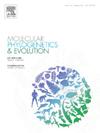综合物种划分方法推断了北美西部Lomatium foeniculaceum复合体的物种边界,并指出了其从西南向东北的进化史。
IF 3.6
1区 生物学
Q2 BIOCHEMISTRY & MOLECULAR BIOLOGY
引用次数: 0
摘要
物种边界的划定一直是系统学领域的难题。当变异很微妙时,要确定形态变异是环境参数、早期物种形成还是完全物种形成的结果尤其具有挑战性。在Apiaceae (PENA)的北美多年生特有种分支中,有许多例子表明,广泛分布的物种具有微妙的地理上定义的形态变异,这些变异通常被认为是亚种级。小茴香(坚果)库尔特和玫瑰物种复合体是一个突出的例子,长期以来一直被视为具有五个下丛的单一物种,在形态连续体中跨越了美国西部和加拿大西部的大部分地区:L. foeniculaceum var. foeniculaceum, L. foeniculacum var. dauciolium (Torr。克朗奎斯特,l.f eniculacum varmacdougalii (J.M. Coult)。克朗奎斯特,l.f eniculacum变种毡状体(W.L. Theob)B. Boivin,和L. foeniculacum var. inyoense (Mathias & Constance)利用Angiosperm353 baits试剂盒对这5个亚特异类群的核位点进行分析,以确定这些亚特异类群是否形成了离散的遗传群。然后,对鉴定出的类群进行形态学和生态学特征的综合检查,以确定恢复类群的最合适的分类等级。分子数据恢复了六个支持良好的单系进化枝和一个单一个体的第七枝。最初鉴定为L. foeniculacum var. macdougalii的样品分为两个分支,与L. foeniculacum var. foeniculacum /L有一个姊妹。鸢尾花是鸢尾花的另一个姐妹花。大部分样本在同一枝上;另一些则根据分析结果与L. foeniculacum var. daucifolium同属分支。每个分支都具有不同的形态诊断特征状态。我们的结论是,分子数据和形态学支持在复合体中识别五个不同的物种:L. inyoense Mathias & Constance, L. macdougalii J. M. Coult。&罗丝,l.f imbriatum (W.L. Theob)博特罗& J.F. Sm。, J.F. m.;和小叶乳香,保留了小叶乳香和小叶乳香两个品种。这些数据表明,大陆分水岭对这些物种的进化产生了影响,作为促进物种形成的有效屏障。本文章由计算机程序翻译,如有差异,请以英文原文为准。

Integrative species delimitation methods infer species boundaries in the Lomatium foeniculaceum complex and indicate an evolutionary history from the Southwest towards the Northeast in western North America
Delimiting species boundaries is a perennial challenge in the field of systematics. Resolving whether morphological variation is the result of environmental parameters, incipient speciation, or complete speciation is especially challenging when the variation is subtle. Within the perennial endemic North American clade of Apiaceae (PENA) there are numerous examples in which widespread species have subtle geographically defined morphological variants that have typically been recognized at the subspecific rank. The Lomatium foeniculaceum (Nutt.) Coult & Rose species complex is a salient case that has long been treated as a single species with five infrataxa, spanning much of the western United States and western Canada in a morphological continuum: L. foeniculaceum var. foeniculaceum, L. foeniculaceum var. daucifolium (Torr. & A. Gray) Cronquist, L. foeniculaceum var. macdougalii (J.M. Coult. & Rose) Cronquist, L. foeniculaceum var. fimbriatum (W.L. Theob.) B. Boivin, and L. foeniculaceum var. inyoense (Mathias & Constance) B. Boivin. We utilized the Angiosperm353 baits kit to sample nuclear loci from these five taxa to determine if the subspecific taxa formed discrete genetic groups with the molecular data. Groups that were identified were then examined for a combination of morphological and ecological traits that corresponded to these groups and could be used to determine the most appropriate taxonomic ranks of recovered groups. Molecular data recovers six well-supported monophyletic clades and a seventh clade of a single individual. Samples initially identified as L. foeniculaceum var. macdougalii are in two clades with one sister to L. foeniculaceum var. foeniculaceum/L. foeniculaceum var. daucifolium the other sister to L. foeniculaceum var. fimbriatum. Most samples of L. foeniculaceum var. foeniculaceum are in the same clade; others are in the clade with L. foeniculaceum var. daucifolium depending on the analysis. Each clade can be defined with a distinct morphological diagnostic character state. We conclude that molecular data and morphology support the recognition of five distinct species within the complex: L. inyoense Mathias & Constance, L. macdougalii J. M. Coult. & Rose, L. fimbriatum (W.L. Theob.) Botello & J.F. Sm., L. semivaginatum Botello & J.F. Sm., and L. foeniculaceum with two varieties retained, L. foeniculaceum var. foeniculaceum and L. foeniculaceum var. daucifolium. The data suggest that the Continental Divide has been influential in the evolution of these species, acting as an effective barrier facilitating speciation.
求助全文
通过发布文献求助,成功后即可免费获取论文全文。
去求助
来源期刊
CiteScore
7.50
自引率
7.30%
发文量
249
审稿时长
7.5 months
期刊介绍:
Molecular Phylogenetics and Evolution is dedicated to bringing Darwin''s dream within grasp - to "have fairly true genealogical trees of each great kingdom of Nature." The journal provides a forum for molecular studies that advance our understanding of phylogeny and evolution, further the development of phylogenetically more accurate taxonomic classifications, and ultimately bring a unified classification for all the ramifying lines of life. Phylogeographic studies will be considered for publication if they offer EXCEPTIONAL theoretical or empirical advances.

 求助内容:
求助内容: 应助结果提醒方式:
应助结果提醒方式:


